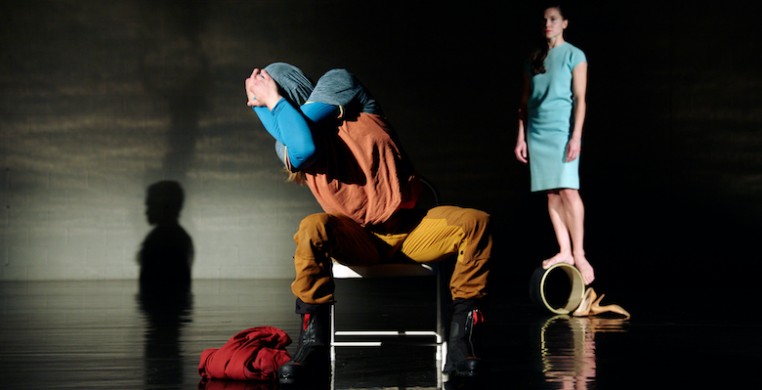The sky isn’t the only thing that was different in Hubbard Street’s “The Sky Was Different,” a world premiere and one of season 43’s virtual performance offerings for these pandemic times.
But first, a big hug and thank you to former Hubbard Street dancer Jonathan Fredrickson for his homage to the Hubbard Street dance artists and their plight during the pandemic. “The Sky was Different” opened free to the public online Thursday and runs through Dec. 6.
I thank Fredrickson, his production collaborators, co-director Tobin Del Cuore, composer Oleg Stepanov, and most of all the collective brain that masquerades as a troupe of brilliant dance artists for having the courage to harvest the shards from many crushing blows to their collective body/mind and produce this testament to their humanity.
I also want to express my gratitude to the Schweiker Preservation Trust and Estate for providing the magnificent setting in which most of the production was staged and filmed.
The existential upheaval of Hubbard Street Dance Chicago has sadly coincided with the global pandemic and the multiple U.S. national crises of COVID-19, racial conflict and a presidential election that has polarized our country’s citizens in a bitter divide. Each of these factors alone could have been a sledge hammer to the fragile ecosystem of any dance company, but together, they comprise what would have been a death blow to most organizations. That Hubbard Street is even registering a pulse under these constraints is nothing short of a miracle. And make no mistake, their collective artistry is alive and well in their every move and utterance. Most apparent however, is their heart-wrenching need to fulfill their innate, life-giving gift of making art.
“The Sky was Different” is a breath of life in the midst of crushing obstacles, a brave beginning and an act of love. Fredrickson and his team are to be admired for the high level of production values and professionalism that went into the development, staging and filming of “The Sky was Different.” In contrast to the early efforts of many performing arts organizations to adapt to a virtual medium, Fredrickson’s film looks and feels like a polished, professional work of art, passionately driven by the most noble of intentions. That is not to say that its creators entirely understand how and why it has landed in the particular form that the finished production embodies.
In a work so deeply dependent on process, the product disappoints on several levels, and yet it seems perhaps a necessary way in to what is an enormous artistic challenge that should, most emphatically, continue to develop.
What I am suggesting here is that the process that produced “The Sky was Different” was the essential and magnificent value of the work, and the product was a mere artifact of that endeavor. Further, I would venture that the “end” product was much more meaningful to the participants, who embodied the whole of the experience within their hearts, than it was to the audience who were not privy to that process.
The finished film authentically represents the confusion, disjointedness, non-sequiturs and random behaviors that these strange times have imposed on us and which have severed us from what we once counted on to give our lives meaning.
As a metaphor for the chaos of our times, the film succeeds magnificently. As a work of art that builds toward a cohesive statement or delivers a central message, not so much. Too much of the 50 minute slice of somatic life fixates on repetition of random behaviors that are not intrinsically interesting to watch, however fascinating or meaningful they may be for those performing those behaviors. For much of the time watching “The Sky was Different,” I felt like an outsider eaves-dropping on a private party that was fascinating only if you were friends of the party guests.
The blend of spoken narrative, choreographed or improvised dance segments, and everyday activities sometimes digressed to an overly-precious embrace of the personal search for meaning.
By contrast, several isolated segments made me sit up and pay attention in a different way, not because they resembled more conventional concert dance, but rather because they embodied a structural logic that was interesting to watch as a combination of movement design, human interaction, emotion and environment. These include Craig Black, Jr. and Kevin Shannon mirroring each other and Andrew Murdock playing with his shadow. The high note of the film for me is the poignant duet, filmed in the studio, between Jaqueline Burnett and David Schultz, in which he repeatedly falls backward off a folding chair and she repeatedly helps him to his feet. The repetition of Schulz’s travail builds tension, frustration and a palpable sense of the depth of meaning in their relationship.
Murdock’s narration of verbs and nouns, spoken in lists separated by “then,” as if predicting a sequence of actions occurring in time, opens the film and recurs periodically. Intriguing if disconnected from anything surrounding it, it suggests a larger metaphoric framework for the randomness of the whole, maybe.
In the spirit of “the going is the goal,” the background materials available online offer revelatory insight and compelling narrative of the process that produced the film. Initiated by Fredrickson’s question, “How are you?” these individual videos, made by several of the participating dancers, are exquisite self-portraits of the artists and should be required watching for anyone viewing the finished film they inspired. Perhaps this is a key to further exploration, which I dearly hope this collection of dedicated artists will grace us with in the future. Clearly, they have something important to say to all of us, not just themselves.
--
"The Sky was Different" runs through Dec. 6 online. Tickets are free but require reservation; donations are encouraged. For more information, click the event page below.


